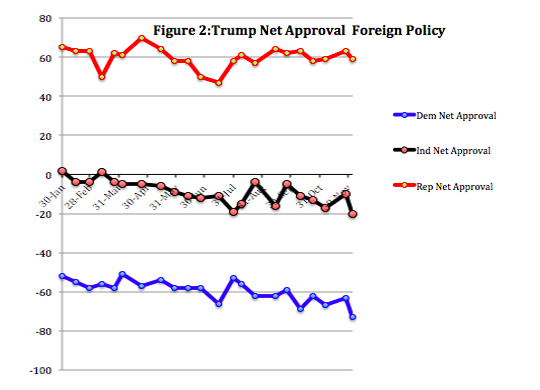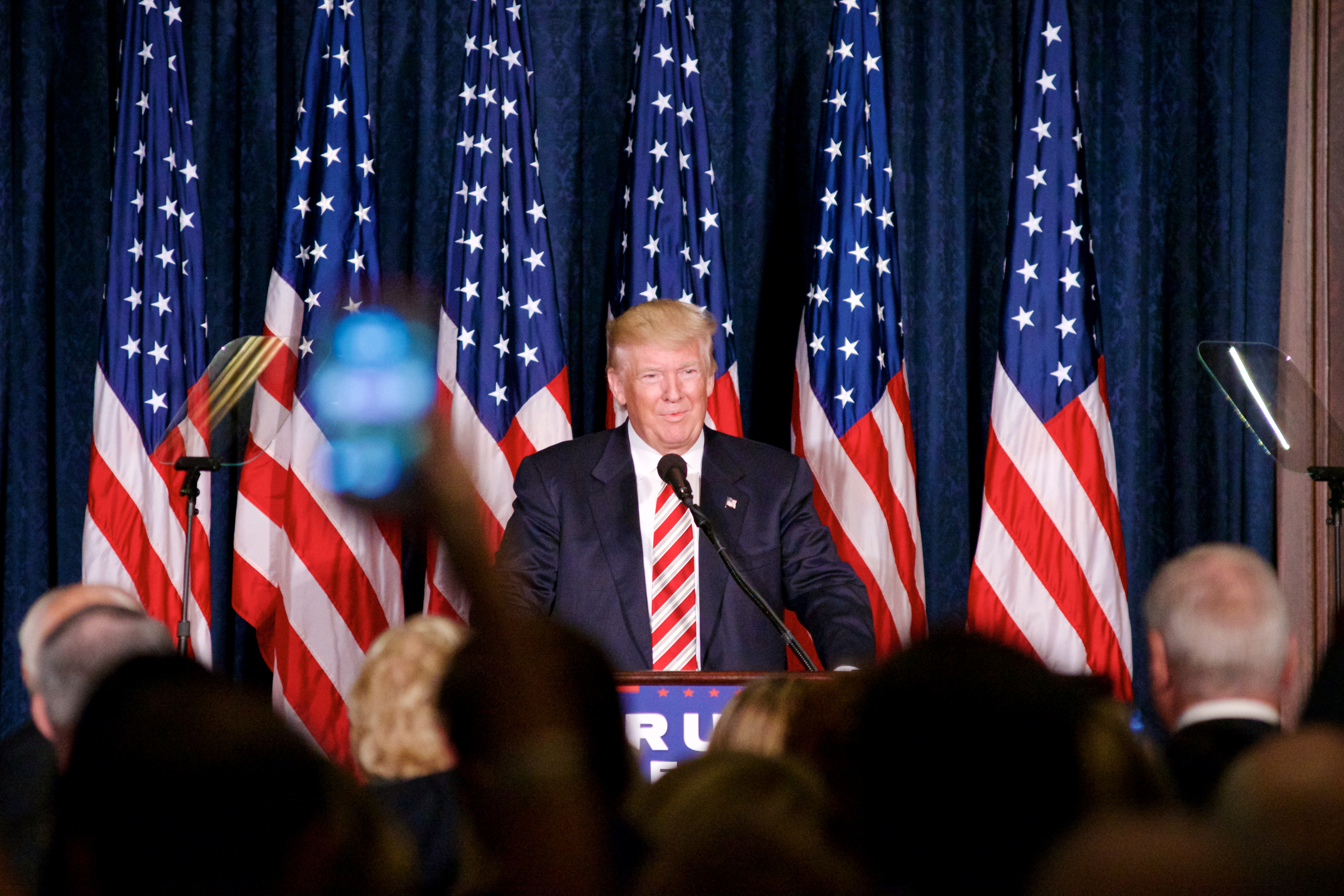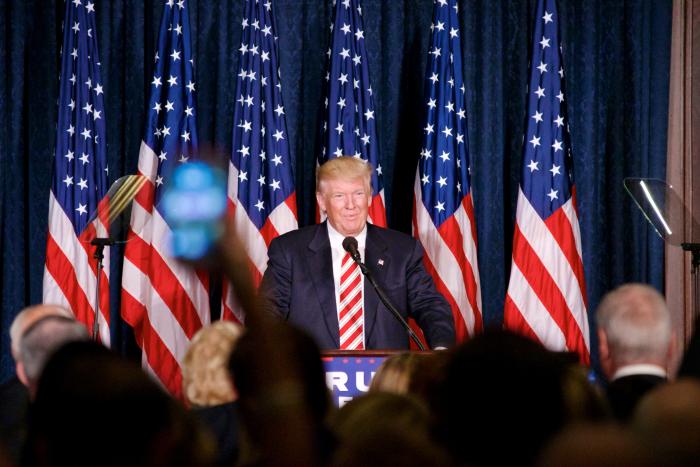- Politics, Institutions, and Public Opinion
Donald Trump’s election came as a surprise to most pundits and pollsters who had expected Hillary Clinton to win. One major reason they thought Clinton would win is that, over the course of the campaign, Republican identifiers and elites had doubts about Trump’s temperament and ability to be President.
But as election day got closer, Republicans who had been reluctant to support him ultimately chose him over Clinton. In August 2016, the YouGov Recontact Poll—in which 5,000 people were ultimately interviewed 17 times between May 2016 and September 2017—showed that only 76 percent of Republicans said that they were voting for Trump, while 82 percent of Democrats were voting for Clinton. Over the post-Labor Day campaign period, Republicans moved to Trump, who got 92 percent of their vote on election day, with only 4 percent voting for Clinton. In contrast, 7 percent of Democrats voted for Trump and only 88 percent voted for Clinton. However, given the Democratic edge in identifiers (roughly a 5 percent advantage), Trump could not have won without taking the Independent vote. In the YouGov Recontact survey, 54 percent of said Independents voted for Trump, with only 34 percent voting for Clinton. Thus, Trump is President largely because Republican voters came around to him and Independents voted for him over Clinton.
Given these two crucial points, the analysis now turns to how Trump is faring a year into his presidency. Drawing on two surveys per month from the weekly YouGov/Economist poll, I examine partisan and Independent overall approval of the President, in addition to their opinions on his handling of the economy and foreign policy. The measure used is the difference between approval and disapproval (net approval); thus, if 65 percent disapprove and 35 percent approve, the score is -30 percent approval. Figure 1 shows Trump’s overall approval/disapproval score by Democrat, Republican, and Independent from January 30 to December 4, 2017.
Among Republicans, Trump began with a net approval of around 75 percent, which fell into the 50s in June and July, and is now back up to a net approval of around 65 percent. This loss of ten points has mostly come from Republicans who were slower to come around to voting for him. The YouGov Recontact Poll showed that if in May 2016 a Republican was committed to Trump, in September 2017, 60 percent liked him a lot, 31 percent liked him somewhat, and only 5 percent disliked him. In contrast, of those Republicans who, in early May, were for another candidate, only 13 percent liked him a lot in September 2017 and 37 percent disliked him. Republicans who were undecided in May 2016 fit between the early Trump supporters and those supporting others, with 20 percent of them in September liking Trump a lot and 21 percent disliking him. In short, his base, those who were with him early, are especially supportive, while those who came around later are less supportive.
Trump has also lost some support from women who, while never approving of him, were early in his presidency less negative (single digits). By mid year, though, his net approval among women rose to -20 and has remained there. The decline in support from women has not been offset by an increase in men’s approval ratings, although men‘s net negatives are in the single digits. Of course, this lack of support at present does not mean that those Republicans who like him less or approve of him less will vote Democratic in 2020. Indeed, given the current list of possible Democratic presidential candidates, the odds are that they would choose Trump over a Sanders-like Democrat.
What these voters would do if a Republican or Republicans ran against him in a primary is another matter, and here we find some troubling data for the President. Beginning in August 2017, YouGov asked the following question: “Do you want Donald Trump to run for re-election in 2020?” Averaging all answers over Republican respondents yielded 63 percent saying yes and 37 percent saying no or not sure (19 percent no, 18 percent not sure). While there are no equivalent numbers for other presidents, this number of negative and undecided responses seems high. However, in August, when asked if Jeb Bush, Marco Rubio, John Kasich, Ted Cruz, or Mitt Romney would make a better or worse president than Trump, all of these potential candidates lost to Trump—with only Vice President Pence winning out over the President. Thus, while there appears to be dissatisfaction with the President within his party, it is not clear which, if any, Republicans could beat him in 2020.
Democrats started out anti-Trump and, over the entire time series, have continued to disapprove of the President’s job performance. This dislike is unsurprising, given the country’s entrenched partisan polarization. Republicans were similarly down on President Barack Obama in the first six months of his presidency, giving him a 16 percent approval rating and an 82 percent disapproval rating. Over the last year, Democrats have become a little more anti-Trump, moving from a -68 net approval in January to a rating in the high negative 70s at year’s end. Overall, the Democrats were anti-Trump from the start, and they remain so at a slightly higher level.
Independents, on the other hand, have moved from a net positive approval rating in January to a steadily increasing net negative one. In June, the gap against Trump was in double digits, and, by early August, it was at about 20 points, with 30 percent approval and 51 percent disapproval in the August 8 poll. Trump’s net approval numbers slowed in the fall, but he is now back to around negative 20 points. When asked “Do you want Trump to run in 2020?” Independents are clear that they don’t want him to run. In August 2017, 54 percent said they did not want him to run again, with only 20 percent saying yes, and those numbers remained steady through the year, with 56 percent of Independents saying no to 22 percent saying yes he should run again, in December.
With regard to who would be a better President, Independents exactly reverse the Republican respondents’ positions, with Bush, Rubio, Kasich, Cruz, and Romney all seen as better than Trump, and Pence losing out to the President by 3 percent. Clearly, Trump has lost support among the Independents who ultimately gave him his victory over Clinton. The YouGov Recontact post-election survey found that 61 percent of Independents who voted for Trump voted against Clinton, and about a quarter of them came to Trump late in the campaign. On the positive side, it should be noted that Independents who voted for Trump still like him (78 percent), think the press treats him unfairly, and overwhelmingly think that he should not be impeached (90 percent). Nevertheless, in regard to his electoral coalition, it seems clear that the President has lost some appeal with these crucial voters, and it is not clear that he can count on these voters in the 2020 election.

We also looked at Trump’s approval/disapproval numbers for his handling of foreign affairs (Figure 2). As was the case in overall approval, Democrats started out negatively and have become more negative over time, while Republicans started out positively and remain at about the same level of support after Trump’s first year in office. There is no apparent pattern to the data, in that specific events, such as the North Korean missiles, tiffs with the Australian Prime Minister, etc., do not drive the responses; rather, it appears to be the accumulation of the year’s record that moved the Democrats to being more negative and the Independents to shifting to net negative ratings.
The bright spot for the President is the economy (Figure 3). Republicans have given him high marks on the economy, and they continue to do so at or near the 70-point positive level. Democrats, while not negative, are less anti-Trump on his handling of the economy, with as many as 20 percent giving him positive marks. Significantly, Independents—who began with a slightly positive approval number on Trump’s handling of the economy—have held constant at roughly 50 percent approval/50 percent disapproval, with the number slightly negative at year’s end. Thus, on the most important single issue to U.S. voters, Trump is out-performing his overall approval rating among Independents by a full 15 points.

The overall story for the first year of the Trump era is that the President has maintained his co-partisans’ approval, never had the Democrats’ approval, and has lost some support among Independents. Carefully monitoring future developments among Independents is critical—as long as there are fewer Republicans than Democrats in this country, Independents will remain absolutely essential to Republican electoral success. At the moment, they are less supportive of Trump than they were in January—and may be poised to become even less supportive if the nation’s economic fortunes take a hit.
















